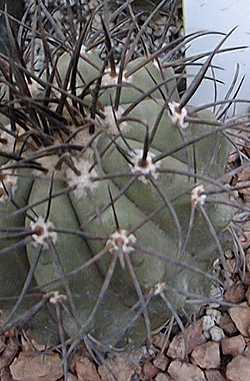USDA: 10b-11
Frost Tolerance: Hardy to 32°F (0°C)
Sun Exposure: Light shade
Origin: Coastal deserts of northern Chile (Antofagasta, Caldera)
Growth Habits: Soiltary or slowly clumping, depressed spherical or cylindrical, 6 inches tall (15 cm), 4 in. (10 cm) in diameter; 10 to 17 ribs; 1( to 2) central spines, 0.88 to 1.2 inches (2.2 to 3 cm) long; 5 to 7 radial spines, 0.52 to 0.6 inch (1.3 to 1.5 cm) long;
Watering Needs: Light watering, good drainage. Keep warm and dry in winter to avoid rot.
Propagation: Seeds (offsets rarely), or grafted
The wild Copiapoa calderana have a whitish grey bloom that is generally not present on the cultivated cactus. There is very little rain where Copiapoas come from, and most of the species get a significant part of their water from the frequent fog.
Copiapoa is named after the city of Copiapó in northern Chile. 'Calderana' refers to Caldera, another location in Chile.
The name Copiapoa lembckei was not validly published.
Blooming Habits:
Large light yellow funnel-shaped flowers in spring and summer, 1.2 to 1.4 inches (3 to 3.5 cm) in length, 1.2 inches wide (3 cm), followed by green fruit.
Desert-Tropicals is dedicated to provide gardening advice, gardening ideas, and information about flower of all kind for landscape and collections.We try to check carefully the identification of the plants on the illustrations as well as the other information from the page, but occasionally errors do occur. if you notice anything that needs to be changed please contact us.Thanks.
© 1998-2020 Philippe Faucon, All Rights Reserved.
